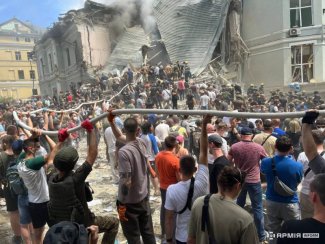Russia damages a children’s hospital in Kyiv. Day 866 of the war


On the 8 July at night and in the morning, Russia launched a large-scale air attack against Kyiv, Dnipro, Kryvyi Rih and other locations. They used 44 different types of missile, including one Kinzhal and one Zirkon hypersonic missile. Ukrainian air defence declared it had shot down 33 of the missiles. One Kh-101 missile struck Okhmatdyt, the largest specialised children’s hospital in Ukraine, located in central Kyiv. The modern medical complex which was opened a few years before the war was among the parts severely damaged. Other civilian buildings were destroyed or damaged in Kyiv, as well as three electrical substations. In total, across the whole of Ukraine, at least 37 people were killed (32 in the capital) and around 200 were injured.
The aerial bombardment of Kyiv on 8 July should be recognised as intentional action from Russia on the eve of the NATO summit in Washington DC. The Kremlin’s aim is to demonstrate to the West its determination to prosecute the war further. A direct missile hit on a large hospital in the centre of a densely populated city is a war crime.
On the 3 July, Russia attacked Dnipro using three Iskander-K cruise missiles, four Kh-59 cruise missiles and five Shahed 136/131 drones. Ukraine’s air defence declared it shot down the majority of the rockets and drones, besides the two Iskanders. The main target of the attacks was the Pivdenmash factory. Five people died and dozens were injured.

On the 4 July the spokesperson for the Khortytsia operational-strategic group stated that the final Ukrainian units had retreated from the outskirts of Chasiv Yar on the east bank of the Donets-Donbas canal. The buildings in this area have been entirely destroyed by artillery and aerial bombardment, which rendered further defence impossible. Direct fighting for the outskirts had been ongoing for the last three months. At great cost, Russia has so far taken a small part of Chasiv Yar (around 10% of the area of the city in its administrative borders). Russia came out on the line of the canal at a 5 km-wide section which is flanked by Ukrainian positions from north to south. The front line in this region creates significant difficulties for Russia in its further attacks westward; this is especially true where Ukraine holds a large node of resistance around Klishchiivka and Andriivka. The Donets-Donbas canal, although it is empty, also constitutes a major obstacle in the terrain. Hills and blocks of flats and industrial buildings on the western side are crucial from the tactical point of view. The Ukrainians have favourable conditions for defence there and can inflict heavy losses on Russia over the coming months. One crucial factor for how the battle for Chasiv Yar develops is ensuring rotation and artillery support for the infantry defending the city, and also the appropriate preparation of the the terrain in engineering terms.
Russia is continuing its offensive actions in the region of Niu-York and Toretsk, achieving tactical successes. In recent days they were able to move forward five kilometres into a Ukrainian grouping in the region of Niu-York; fighting is already underway on its outskirts. The reasons for the local break in the Ukrainian defences are not fully understood but should be sought for in a badly organised brigade rotation which was carried out in June. However, it appears that the retreat came along with a stabilisation of the situation in this direction – at least for the short term.
Over the last week Russia has made small progress in the Ocheretyne region, pushing Ukrainians back from further points of resistance (around the villages of Yevhenivka, Novoprokovske and Umanske). In this direction, Russian troops are close to reaching the River Vovcha at the section from the Avdiivka-Pokrovska railway line to the road linking those two towns. The Vovcha, and the ponds created alongside it, is a major obstacle in the terrain and a favourable defensive perimeter for the Ukrainian Army.

On 7 July Ukrainian drones struck an ammunition depot in Sergeyevka in the Voronezh region (around 200 km from the border with Ukraine). This resulted in large explosions. In recent days Ukraine has also effectively hit energy and fuel infrastructure facilities in Krasnodar Krai and in the Rostov and Volgograd regions. Among the consequences of these strikes were fires at fuel storage facilities.

On 6 April a transport plane with Chinese special forces landed at the Baranovichi air base in Belarus (most likely there was a company of 60–100 soldiers). They were being transported to a training ground near Brest (8 km from the Polish border, 28 km from the Ukrainian border) where joint anti-terror training began which is scheduled to continue until 19 July. This will include: overcoming water obstacles and combat in built-up areas. China stressed that the activity was part of the ‘annual cooperation plan’ (signed in April 2023) during the Chinese defence minister’s visit to Minsk). Belarusian military officials said that the drills are occurring against the backdrop of a complicated international situation requiring the improvement of the qualifications of both armies’ soldiers.
Similar exercises have been held before but the current ones are taking place at the same time as the NATO summit in Washington DC and are a sign of hostility from Beijing against an alliance which in Chinese propaganda is called a “relic of the Cold War” and criticised for strengthening relations with the countries of the Indo-Pacific. They also show support for the Minsk regime and emphasise the importance of military links with Belarus, which joined the Shanghai Cooperation Organisation a few days earlier. The exercises were accompanied by an intensive disinformation campaign from Minsk about the alleged increasing military threat from Ukraine and Poland.
On 8 July, Indian Prime Minister Narendra Modi visited Russia and obtained Vladimir Putin’s agreement to release Indians fighting in the Russian army. So far at least two Indian citizens have died at the front in Ukraine and dozens are in the war zone. They claim that they were tricked while signing contacts and that they do not agree to participate in combat. The Indian government had already dismantled a group of agents enlisting Indians and smuggling them into Russia.

On 3 July, Ukraine’s ministry of defence announced that over two million men had updated their data using the “Reserv+” app. Servant of the People MP and chariman of the parliamentary committee on economic development Dmytro Natalukha claims that over 11 million people may be mobilised, including 565,000 who have been temporarily exempted from service (e.g. due to obtaining the status of an employee in a strategic sector of the economy).
On 4 July President Volodymyr Zelensky gave an interview to the Bloomberg agency in which he stated that due to delays in the delivery of Western weapons, 14 brigades cannot be sent to the front. He added that these units are also struggling with shortages of men.
At the end of June and the beginning of July, the Ukrainian media intensified the discussion over the low level of command in brigades and operational groups. They criticise the incompetence of commanders who waste the lives of soldiers and cause the decimation of entire companies and battalions for the sake of insignificant points of resistance. There is a particularly bad situation in some battalions of the Territorial Defence Forces, which are poorly armed and undermanned and which are not fighting in their home brigades but are randomly assigned to regular infantry brigades and used by their seniors in an irrational manner. These discussions are further proof of the crisis in Ukraine’s infantry, which is suffering from a lack of trained replenishment and command problems, in particular at the brigade-operational group level.

On 3 July the US announced the latest package of military aid for Ukraine, worth a further $2.35 bn. As part of the Presidential Drawdown Authority mechanism, the following arms will go to Ukraine for American arms depots: 155 mm, 105 mm and 81 mm artillery ammunition, HAWK and Patriot air defence systems missiles, TOW, Javelin and AT-4 anti-tank systems for $150 mn. The second part of the package, worth $2.2 bn, as part of the Ukraine Security Assistance Initiative is intended for the purchase of missiles for the Patriot and NASAMS air defence systems in the American industry.
7 July – within two days of the new government being in place – the UK presented a new military aid package for Ukraine. Its value has not been disclosed. It contains 250,000 12.7 mm calibre rifle rounds, 90 Brimstone heavy anti-tank missiles, 50 small riverboats, 40 demining vehicles, 61 bulldozers and 10 AS-90 howitzers, with 32 replacement barrels and 60,000 155 mm shells. On the same day, the Netherlands declared that it was sending Ukraine a radar and three Patriot air defence launchers and will send €10 mn for the IT coalition.
On 8 July Germany announced further deliveries for the Ukrainian Armed Forces. This will include: a third Patriot air defence system battery, two TRML-4D radars, 9,000 35 mm shells for the Gepard self-propelled anti-aircraft guns, 55,000 155 mm artillery shells, 30 VECTOR reconnaissance drones and 10 unmanned naval vessels, 200 mobile drone jammers, 58,000 40 mm grenades and around 1,400 various small arms.
Also on 8 July, Ukraine and Poland signed an Agreement on Security Cooperation. The document mentions that, since the beginning of 2022, Poland has given the Ukrainian Army 44 arms and ammunition packages of various kinds and provided other support – especially in the form of training, logistics, supplies, maintenance and repair, and in medicine – worth a total of €4 bn. It was announced that in 2024, it will deliver several significant military aid packages and will continue its support over the coming decade. Poland intends to continue running the POLLOGHUB logistics hub with air, road and rail modules, and has decided to maintain its leading role in ensuring arms and materiel for Ukraine.
The parties are considering the delivery of a squadron of Polish MIG-29 fighter jets, on the condition that this is not detrimental to the operational capabilities of the Polish Air Force. There was an announcement of the intention to continue bilateral and multilateral dialogue to investigate the rationale and feasibility of the possible interception in Ukraine’s airspace of missiles and UAVs fired in the direction of Poland. It will, however, be necessary for the countries and organisations to develop procedures in this area. At Kyiv’s request, Warsaw will encourage Ukrainian citizens to return home to undertake military service. Cooperation in the area of training Ukraine’s security and defence forces on Polish territory will continue. Ukrainian citizens temporarily residing in Poland and other countries can participate in this process. Unlike other similar agreements, great significance was attached to indicating the main directions of political cooperation (including the possibility of signing interstate treaty).

On 3 July the European Council on Foreign Relations (ECFR) published research carried out among Ukrainians living in Ukraine and in 14 EU countries. One of the questions was on the choice between Ukraine retaining its sovereignty or regaining its territory. 45% of those surveyed accepted the possibility of losing part of the occupied territories to maintain sovereignty and the freedom to choose its alliances, such as the EU and NATO. 26% agreed that regaining the occupied territories in exchange for demilitaritsation and forgoing the right to join military and political alliances. 29% did not choose either option.





